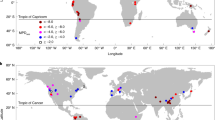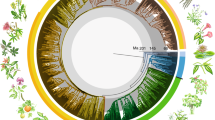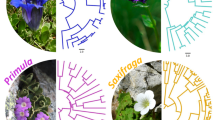Abstract
The Succulent Karoo is an arid region, situated along the west coast of southern Africa. Floristically this region is part of the Greater Cape Flora1 and is considered one of the Earth's 25 biodiversity hotspots2. Of about 5,000 species occurring in this region, more than 40% are endemic3. Aizoaceae (ice plants) dominate the Succulent Karoo both in terms of species numbers (1,750 species in 127 genera) and density of coverage3,4. Here we show that a well-supported clade within the Aizoaceae, representing 1,563 species almost exclusively endemic to southern Africa, has diversified very recently and very rapidly. The estimated age for this radiation lies between 3.8 and 8.7 million years (Myr) ago, yielding a per-lineage diversification rate of 0.77–1.75 per million years. Both the number of species involved and the tempo of evolution far surpass those of any previously postulated continental or island plant radiation5,6,7. Diversification of the group is closely associated with the origin of several morphological features and one anatomical feature. Because species-poor clades lacking these features occur over a very similar distribution area, we propose that these characteristics are key innovations that facilitated this radiation.
This is a preview of subscription content, access via your institution
Access options
Subscribe to this journal
Receive 51 print issues and online access
$199.00 per year
only $3.90 per issue
Buy this article
- Purchase on Springer Link
- Instant access to full article PDF
Prices may be subject to local taxes which are calculated during checkout

Similar content being viewed by others
References
Jürgens, N. A new approach to the Namib region. Part 1: phytogeographic subdivision. Vegetatio 97, 21–38 (1991)
Myers, N., Mittermeier, R. A., Mittermeier, C. G., da Fonseca, G. A. B. & Kent, J. Biodiversity hotspots for conservation priorities. Nature 403, 853–858 (2000)
Jürgens, N. Untersuchungen zur Ökologie sukkulenter Pflanzen des südlichen Afrika. Mitt. Inst. Allg. Bot. Hamburg 21, 139–365 (1986)
Ihlenfeldt, H.-D. Diversification in an arid world: The Mesembryanthemaceae. Annu. Rev. Ecol. Syst. 25, 521–546 (1994)
Richardson, J. E. et al. Rapid and recent origin of species richness in the Cape flora of South Africa. Nature 412, 181–183 (2001)
Richardson, J. E., Pennington, R. T., Pennington, T. D. & Hollongsworth, P. M. Rapid diversification of a species-rich genus of neotropical rain forest trees. Science 293, 2242–2245 (2001)
Baldwin, B. G. & Sanderson, M. J. Age and rate of diversification of the Hawaiian silversword alliance (Compositae). Proc. Natl Acad. Sci. USA 95, 9402–9406 (1998)
Schmiedel, U. & Jürgens, N. Community structure on unusual islands: quartz-fields in the Succulent Karoo, South Africa. Plant Ecol. 142, 57–69 (1999)
Hendey, Q. B. Langebaanweg. A Record of Past Life (South African Museum, Cape Town, 1982)
Axelrod, D. I. & Raven, P. H. in Biology and Ecology of Southern Africa (ed. Werger, M. J. A.) 77–130 (The Hague, Junk, 1978)
Ward, J. D., Seely, M. K. & Lancaster, N. On the antiquity of the Namib. S. Afr. J. Sci. 79, 175–183 (1983)
Ward, J. D. & Corbett, I. Towards an age of the Namib. Transvaal Mus. Monogr. 7, 17–26 (1990)
Magallón, S. & Sanderson, M. J. Absolute diversifiation rates in Angiosperm clades. Evolution 55, 1762–1780 (2001)
Eriksson, O. & Bremer, B. Pollination systems, disperal modes, lifeforms, and diversification rates in Angiosperm families. Evolution 46, 258–266 (1992)
Mayhew, P. J. Shifts in hexapod diversification and what Haldane could have said. Proc. R. Soc. Lond. B 269, 969–974 (2002)
Hulbert, R. C. Jr The rise and fall of an adaptive radiation. Paleobiology 19, 216–234 (1993)
McCune, A. R. in Molecular Evolution and Adaptive Radiation (eds Givnish, T. J. & Sytsma, K. J.) 585–610 (Cambridge Univ. Press, 1997)
Scott, L., Steenkamp, M. & Beaumont, P. B. Palaeoenvironments in South Africa at the Pleistocene–Holocene transition. Quat. Sci. Rev. 14, 937–947 (1995)
Landrum, J. V. Wide-band tracheids in leaves of genera in Aizoaceae: the systematic occurrence of a novel cell type and its implications for the monophyly of the subfamily Ruschioideae. Pl. Syst. Evol. 227, 49–61 (2001)
Mauseth, J. D., Uosumi, Y., Plemons, B. J. & Landrum, J. V. Structural and systematic study of an unusual tracheid type in cacti. J. Plant Res. 108, 517–526 (1995)
Parolin, P. Seed expulsion in fruits of Mesembryanthema (Aizoaceae): a mechanistic approach to study the effect of fruit morphological structures on seed dispersal. Flora 196, 313–322 (2001)
Klak, C., Khunou, A., Reeves, G. & Hedderson, T. A phylogenetic hypothesis for the Aiozoaceae (Caryophyllales) based on four plastid DNA regions. Am. J. Bot. 90, 1433–1445 (2003)
Swofford, D. L. PAUP*4.0b2: Phylogenetic Analysis Using Parsimony (Sinauer Associates, Sunderland, Massachusetts, 1998)
Fitch, W. M. Toward defining the course of evolution: minimum change for a specified tree topology. Syst. Zool. 20, 406–416 (1971)
Felsenstein, J. Confidence limits on phylogenies: an approach using bootstrap. Evolution 39, 783–791 (1985)
Sanderson, M. J. A non parametric approach to estimating divergence times in the absence of rate constancy. Mol. Biol. Evol. 14, 1218–1232 (1997)
Rambaut, A. & Charleston, M. TreeEdit version 1.0 alpha 4–61 [online] 〈http://evolve.zoo.ox.ac.uk/software/TreeEdit.html〉 (2000).
Scott, L., Anderson, H. M. & Anderson, J. M. in Vegetation of Southern Africa (eds Cowling, R. M., Richardson, D. M. & Pierce, S. M.) 62–84 (Cambridge Univ. Press, 1997)
Tankard, A. J. & Rogers, J. Late Cenozoic palaeoenvironments on the west coast of Southern Africa. J. Biogeogr. 5, 319–337 (1978)
Wikström, N., Savolainen, V. & Chase, M. Evolution of the angiosperms: calibrating the family tree. Proc. R. Soc. Lond. B 268, 1–10 (2001)
Acknowledgements
We thank P. Bruyns, A. Ellis and T. Verboom for critical discussion and comments, and G. Aguilar, F. Conrad and A. Khunou for technical support. This research was supported by the National Botanical Institute, Cape Town, the Mesemb Study Group (UK) and grants from The National Research Foundation, and by The University of Cape Town's University Research Committee (T.A.H.).
Author information
Authors and Affiliations
Corresponding author
Ethics declarations
Competing interests
The authors declare that they have no competing financial interests.
Rights and permissions
About this article
Cite this article
Klak, C., Reeves, G. & Hedderson, T. Unmatched tempo of evolution in Southern African semi-desert ice plants. Nature 427, 63–65 (2004). https://doi.org/10.1038/nature02243
Received:
Accepted:
Issue Date:
DOI: https://doi.org/10.1038/nature02243
This article is cited by
-
Diversification of flowering plants in space and time
Nature Communications (2023)
-
Linking the evolution of development of stem vascular system in Nyctaginaceae and its correlation to habit and species diversification
EvoDevo (2022)
-
Evolutionary rates and adaptive radiations
Biology & Philosophy (2019)
-
Genetic variation among and within Lithops species in Namibia
Plant Systematics and Evolution (2019)
-
Insights into the historical assembly of global dryland floras: the diversification of Zygophyllaceae
BMC Evolutionary Biology (2018)
Comments
By submitting a comment you agree to abide by our Terms and Community Guidelines. If you find something abusive or that does not comply with our terms or guidelines please flag it as inappropriate.



